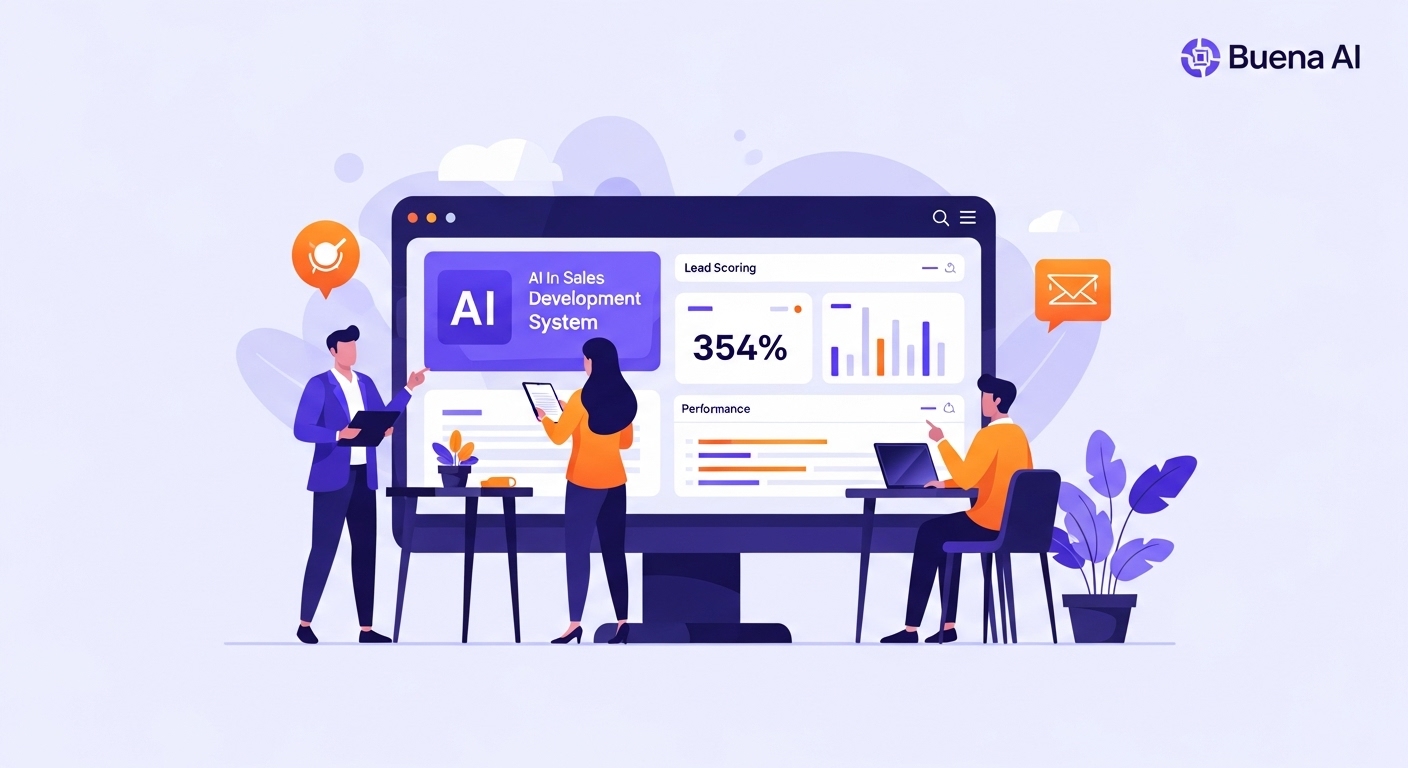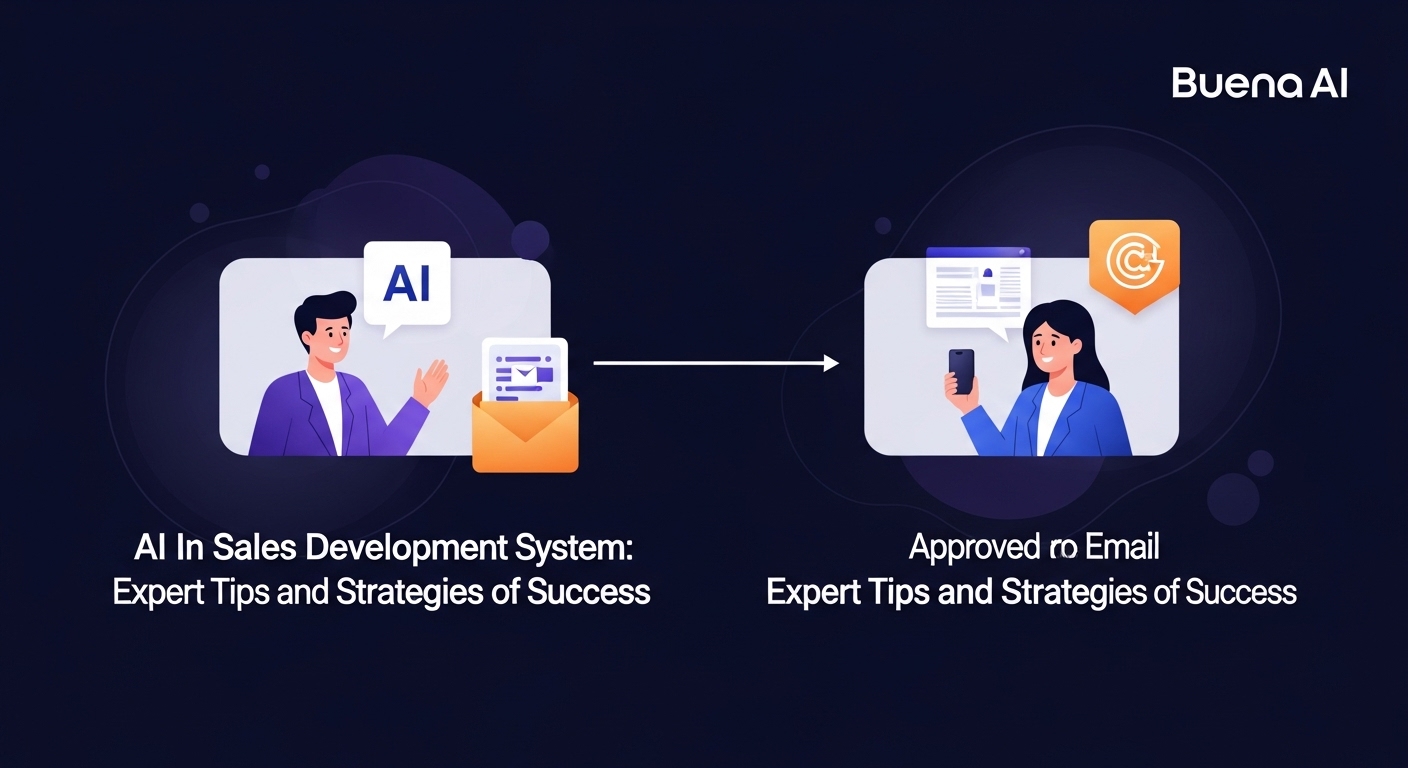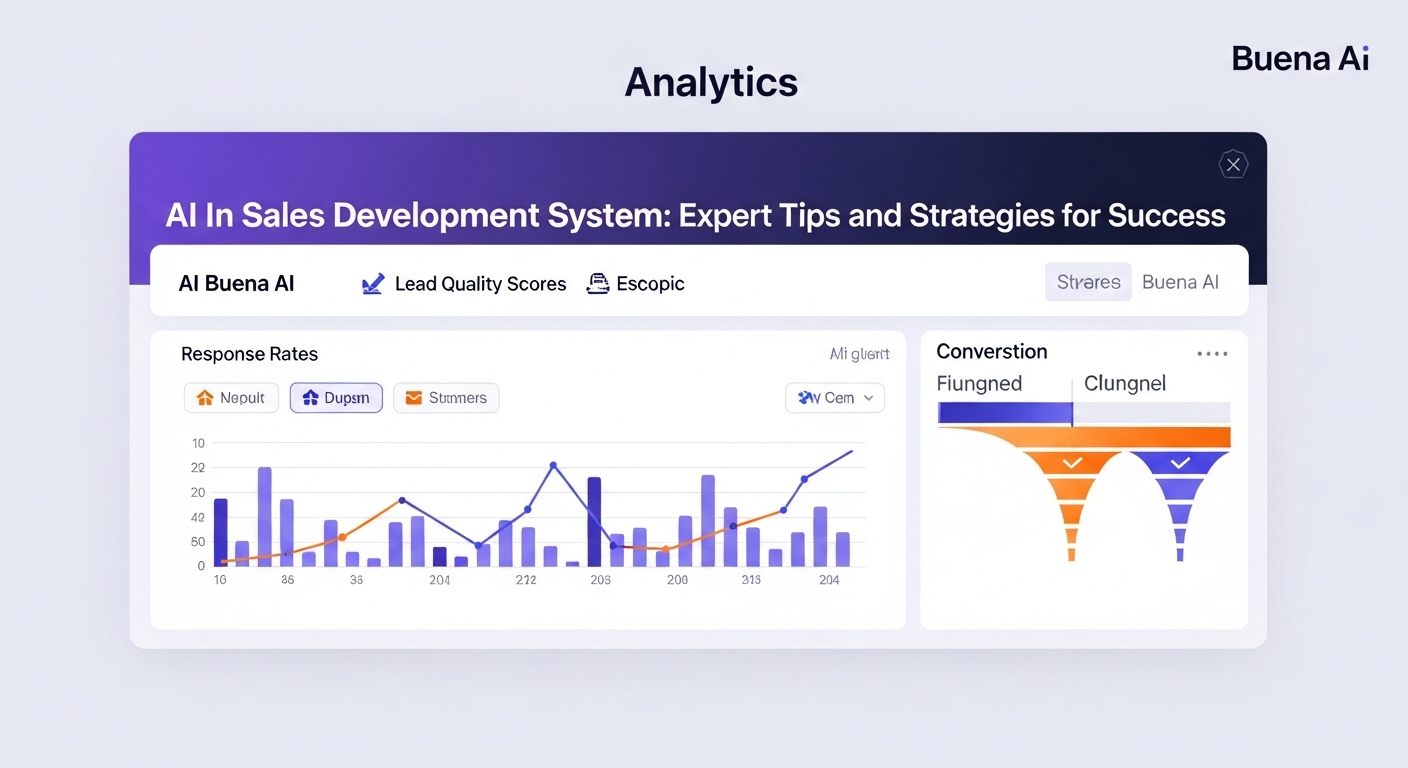AI In Sales Development System: Expert Tips and Strategies for Success
AI In Sales Development System: Expert Tips and Strategies for Success
The sales landscape has fundamentally shifted. While traditional sales development approaches struggle with declining response rates and increasing buyer sophistication, forward-thinking organizations are leveraging AI in sales development systems to achieve remarkable results. Recent studies show that companies using AI-powered sales tools see up to 50% increases in leads and appointments, with some experiencing 3x higher email response rates.
But implementing AI in your sales development process isn't just about adopting new technology—it's about strategically integrating intelligent systems that amplify your team's capabilities while maintaining the human touch that drives meaningful connections. This comprehensive guide explores proven strategies, expert tips, and real-world applications for maximizing your AI in sales development system success.
 modern sales team analyzing AI-powered dashboard with lead scoring metrics and performance analytics
modern sales team analyzing AI-powered dashboard with lead scoring metrics and performance analytics
Understanding the Modern AI Sales Development Landscape
Today's AI in sales development systems go far beyond simple automation. They represent a sophisticated ecosystem of interconnected tools that work together to identify, engage, and nurture prospects more effectively than ever before.
Key Components of Effective AI Sales Development Systems
Intelligent Lead Discovery and Scoring: Modern AI systems can analyze vast databases—some containing over 300 million contacts—to identify prospects that match your ideal customer profile with unprecedented accuracy. These systems use machine learning algorithms to continuously refine their understanding of what makes a qualified lead for your specific business.
Real-Time Buyer Intent Detection: Advanced AI platforms now monitor digital behavior patterns across multiple channels to identify when prospects are actively researching solutions like yours. The best systems achieve up to 87% accuracy in predicting buyer intent, allowing sales teams to prioritize outreach efforts on prospects most likely to convert.
Dynamic Content Generation: AI-powered content creation has evolved to generate personalized emails, LinkedIn messages, and even voice notes that feel authentically human while maintaining the scale and consistency needed for effective sales development.
Predictive Analytics and Forecasting: These systems analyze historical data, current pipeline metrics, and market conditions to provide accurate forecasting and identify the most promising opportunities for immediate attention.
Expert Strategies for Implementing AI in Sales Development Systems
Successfully implementing AI in sales development system strategies requires a thoughtful approach that balances automation with human oversight. Here are the proven strategies that top-performing sales organizations use:
Strategy 1: Human-Guided AI Implementation
The most successful AI implementations don't replace human sales professionals—they amplify their capabilities. This approach involves:
- Training AI on your best performers: Use your top sales reps' successful emails, call scripts, and messaging as training data for AI systems
- Maintaining human oversight: Implement approval workflows for AI-generated content, especially in early implementation phases
- Continuous feedback loops: Regularly review AI performance and provide corrections to improve accuracy over time
For example, sales teams using platforms like Buena AI report that their human-guided approach to AI email generation results in 3x higher response rates compared to generic automation tools, precisely because the AI learns from successful human interactions while maintaining scalability.
 workflow diagram showing human sales rep reviewing and approving AI-generated email content before sending
workflow diagram showing human sales rep reviewing and approving AI-generated email content before sending
Strategy 2: Multi-Channel AI Orchestration
The best AI in sales development systems coordinate outreach across multiple channels for maximum impact:
Email Sequences: AI analyzes recipient behavior to optimize send times, subject lines, and content personalization. Advanced systems can adjust messaging based on previous interactions and engagement patterns.
Social Selling Integration: AI-powered LinkedIn outreach that includes personalized voice notes can achieve 2x higher response rates than text-only messages. The key is using AI to identify the right prospects and timing while maintaining authentic, personalized communication.
Phone and Video Outreach: AI can analyze call recordings to identify successful talk tracks and suggest optimal calling times based on prospect behavior patterns.
Strategy 3: Data-Driven Personalization at Scale
Effective AI in sales development system tips always emphasize the importance of personalization. Modern AI systems can:
- Analyze prospect company news, funding announcements, and industry trends to create timely, relevant messaging
- Identify mutual connections and shared experiences to build rapport
- Customize value propositions based on company size, industry, and current technology stack
- Adapt communication style and tone based on prospect role and seniority level
Measuring Success: KPIs and Optimization Techniques
Implementing AI in your sales development system is only valuable if you can measure and optimize its performance. Here are the critical metrics and optimization strategies that separate successful implementations from failed experiments:
Essential Performance Metrics
Response Rate Improvements: Track email open rates, response rates, and click-through rates before and after AI implementation. Leading organizations typically see 2-3x improvements in these metrics within 90 days of proper implementation.
Lead Quality Scores: Measure how AI-generated leads convert through your sales funnel compared to traditionally sourced prospects. High-performing AI systems should demonstrate higher conversion rates at each stage.
Time-to-Engagement Metrics: Monitor how quickly prospects respond to AI-powered outreach versus traditional methods. Faster engagement often indicates better targeting and messaging relevance.
Sales Velocity Indicators: Track the time from initial contact to qualified opportunity and from opportunity to closed deal. AI should accelerate both timelines through better prospect identification and more effective nurturing.
 comprehensive analytics dashboard showing AI sales development metrics including response rates, lead quality scores, and conversion funnels
comprehensive analytics dashboard showing AI sales development metrics including response rates, lead quality scores, and conversion funnels
Continuous Optimization Techniques
A/B Testing AI-Generated Content: Regularly test different AI-generated subject lines, email templates, and call scripts to identify the highest-performing variations. The best systems make this testing automatic and continuous.
Feedback Integration: Create systematic processes for sales reps to provide feedback on AI-generated leads and content. This feedback should directly influence AI training and improvement.
Competitive Intelligence Integration: Use AI to monitor competitor activities, pricing changes, and market positioning to keep your messaging current and competitive.
Overcoming Common Implementation Challenges
Even the most sophisticated AI in sales development systems face implementation challenges. Understanding and preparing for these obstacles is crucial for success:
Data Quality and Integration Issues
Poor data quality is the fastest way to undermine AI effectiveness. Successful implementations require:
- Clean, standardized data: Invest in data hygiene before implementing AI systems
- Seamless CRM integration: Ensure your AI platform integrates smoothly with existing tools like Salesforce or HubSpot
- Regular data audits: Implement processes to maintain data quality over time
Team Adoption and Change Management
The human element remains critical in AI implementation success:
Comprehensive Training: Provide thorough training on AI tools and their proper use. Sales teams need to understand not just how to use the technology, but when and why to use it.
Gradual Rollout: Implement AI systems gradually, starting with your most tech-savvy team members and expanding based on early success stories.
Clear Success Metrics: Establish clear expectations and success metrics so team members understand how AI will be evaluated and how it benefits their individual performance.
Future-Proofing Your AI Sales Development Strategy
The AI landscape evolves rapidly, and successful sales organizations must stay ahead of emerging trends and capabilities:
Emerging AI Capabilities
Conversational AI: Advanced chatbots and voice AI are becoming sophisticated enough to handle initial prospect qualification, freeing human reps to focus on higher-value activities.
Predictive Pipeline Management: AI systems are increasingly able to predict which deals will close, when they'll close, and what actions are most likely to accelerate the sales process.
Real-Time Coaching: AI-powered coaching systems can provide real-time feedback during calls and meetings, helping reps improve their performance in the moment.
Building Scalable AI Infrastructure
Future-ready organizations invest in AI infrastructure that can grow and adapt:
- Choose platforms that offer robust APIs and integration capabilities
- Prioritize systems that can scale with your team growth
- Invest in training and development to keep your team current with AI capabilities
Conclusion: Maximizing Your AI Sales Development Investment
Successfully implementing AI in sales development systems requires more than just adopting new technology—it demands a strategic approach that combines cutting-edge AI capabilities with human expertise and oversight. The organizations seeing the greatest success are those that view AI as a powerful amplifier of human capabilities rather than a replacement for human sales professionals.
Key takeaways for maximizing your AI sales development investment include:
- Start with clean data and clear objectives
- Implement human-guided AI systems that learn from your best performers
- Focus on multi-channel orchestration for maximum impact
- Measure performance rigorously and optimize continuously
- Invest in team training and change management
- Choose scalable platforms that can grow with your organization
The future of sales development belongs to organizations that can effectively blend AI efficiency with human authenticity. By following these expert strategies and tips, you'll be well-positioned to build an AI-powered sales development system that drives consistent, scalable growth.
Ready to transform your sales development process with AI? The key is starting with the right platform and approach. Consider how advanced AI capabilities like real-time buyer intent detection, dynamic email generation, and seamless CRM integration could accelerate your team's performance while maintaining the personal touch that drives meaningful customer relationships.
Stay Ahead with AI Sales Insights
Get weekly tips and strategies for maximizing your AI sales development system delivered to your inbox
Related Articles
How Does AI Sales Agents Work: Expert Tips and Strategies for Success
Learn how AI sales agents revolutionize B2B sales with proven strategies, expert tips, and real-world examples to boost your sales performance and close more deals.
How to Leverage AI to Its Full Potential: Unlocking Business Creativity in the Age of Artificial Intelligence
Stanford research reveals most businesses aren't fully utilizing AI's creative potential. Learn proven strategies to unlock AI's full power for innovation and competitive advantage.
How MCP Sales Agents Are Revolutionizing B2B Sales Intelligence in 2025
Model Context Protocol (MCP) is transforming B2B sales by enabling AI agents to access real-time enterprise data across systems, creating smarter, more effective sales processes.
